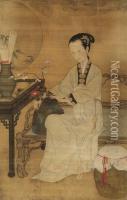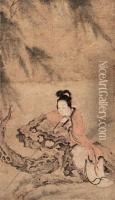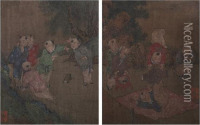Jiao Bingzhen Paintings
Jiao Bingzhen, born in 1689, was a Chinese artist and astronomer during the Qing Dynasty, whose actual date of death remains unknown. His work signifies a period in Chinese history when there was a burgeoning interest in integrating Western techniques and perspectives into traditional Chinese art and science. Jiao was not only a painter but also deeply involved in the imperial court's astronomical activities, which was a testament to his multifaceted talents.
Jiao Bingzhen is most notably recognized for his contributions to the Astronomical Bureau in Beijing, where he worked under the supervision of the Jesuit missionary Ignatius Kögler. Through this collaboration, Jiao gained exposure to Western scientific methods and visual representation techniques, which influenced his work in both astronomy and art. In his astronomical role, he was involved in the creation of a new set of star maps and the highly celebrated calendar of 1683, which was a significant achievement of the time because it combined both traditional Chinese and Western calendrical systems.
In the realm of art, Jiao Bingzhen is best known for his delicate paintings that showcase a unique blend of Chinese subjects with Western perspective and shading techniques—a style that was quite innovative at his time. Among his notable works is the album 'Gengzhi Tu' (耕织图), which illustrates the rice cultivation and silk production processes. This album is a remarkable example of his mastery in applying Western realism to Chinese genre painting, capturing the spirit of Chinese rural life while incorporating the technical sophistication associated with European art.
Jiao's influence extended beyond painting and astronomy. He published a treatise on painting, 'A Study of the Methods of Drawing Figures' (画人像法讲), which outlined the fusion of Western and Chinese painting techniques. This treatise provided valuable insights into figure painting and helped in disseminating the knowledge of Western artistic methods among Chinese artists of the era.
Due to the scarcity of records detailing Jiao Bingzhen's personal life and the circumstances of his death, much of his biography beyond his professional contributions remains a mystery. Nevertheless, his legacy is preserved in his innovative artworks and scientific endeavors, which reflect a significant cultural exchange between East and West during the Qing Dynasty. His works are held in high esteem and can be found in various museum collections, serving as a testament to the enduring relevance of his artistic vision.





